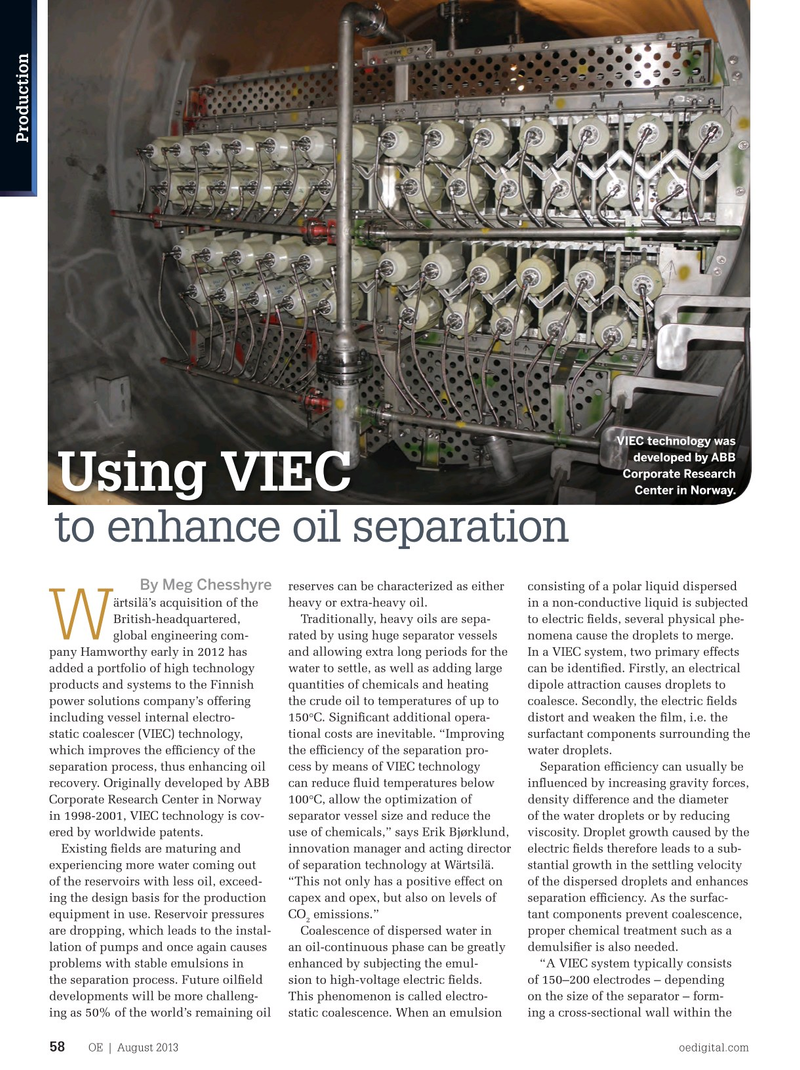
Page 56: of Offshore Engineer Magazine (Aug/Sep 2013)
Read this page in Pdf, Flash or Html5 edition of Aug/Sep 2013 Offshore Engineer Magazine
Production
VIEC technology was developed by ABB
Corporate Research
Using VIEC
Center in Norway.
to enhance oil separation
By Meg Chesshyre reserves can be characterized as either consisting of a polar liquid dispersed ärtsilä’s acquisition of the heavy or extra-heavy oil. in a non-conductive liquid is subjected
British-headquartered, Traditionally, heavy oils are sepa- to electric felds, several physical phe- global engineering com- rated by using huge separator vessels nomena cause the droplets to merge.
W pany Hamworthy early in 2012 has and allowing extra long periods for the In a VIEC system, two primary effects added a portfolio of high technology water to settle, as well as adding large can be identifed. Firstly, an electrical products and systems to the Finnish quantities of chemicals and heating dipole attraction causes droplets to power solutions company’s offering the crude oil to temperatures of up to coalesce. Secondly, the electric felds including vessel internal electro- 150°C. Signifcant additional opera- distort and weaken the flm, i.e. the static coalescer (VIEC) technology, tional costs are inevitable. “Improving surfactant components surrounding the which improves the effciency of the the effciency of the separation pro- water droplets.
separation process, thus enhancing oil cess by means of VIEC technology Separation effciency can usually be recovery. Originally developed by ABB can reduce fuid temperatures below infuenced by increasing gravity forces,
Corporate Research Center in Norway 100°C, allow the optimization of density difference and the diameter in 1998-2001, VIEC technology is cov- separator vessel size and reduce the of the water droplets or by reducing ered by worldwide patents. use of chemicals,” says Erik Bjørklund, viscosity. Droplet growth caused by the
Existing felds are maturing and innovation manager and acting director electric felds therefore leads to a sub- experiencing more water coming out of separation technology at Wärtsilä. stantial growth in the settling velocity of the reservoirs with less oil, exceed- “This not only has a positive effect on of the dispersed droplets and enhances ing the design basis for the production capex and opex, but also on levels of separation effciency. As the surfac- equipment in use. Reservoir pressures CO emissions.” tant components prevent coalescence, 2 are dropping, which leads to the instal- Coalescence of dispersed water in proper chemical treatment such as a lation of pumps and once again causes an oil-continuous phase can be greatly demulsifer is also needed.
problems with stable emulsions in enhanced by subjecting the emul- “A VIEC system typically consists the separation process. Future oilfeld sion to high-voltage electric felds. of 150–200 electrodes – depending developments will be more challeng- This phenomenon is called electro- on the size of the separator – form- ing as 50% of the world’s remaining oil static coalescence. When an emulsion ing a cross-sectional wall within the
OE | August 2013 oedigital.com 58 058_OE0813_ProdOps1_VIEC.indd 58 7/22/13 12:44 AM

 55
55

 57
57